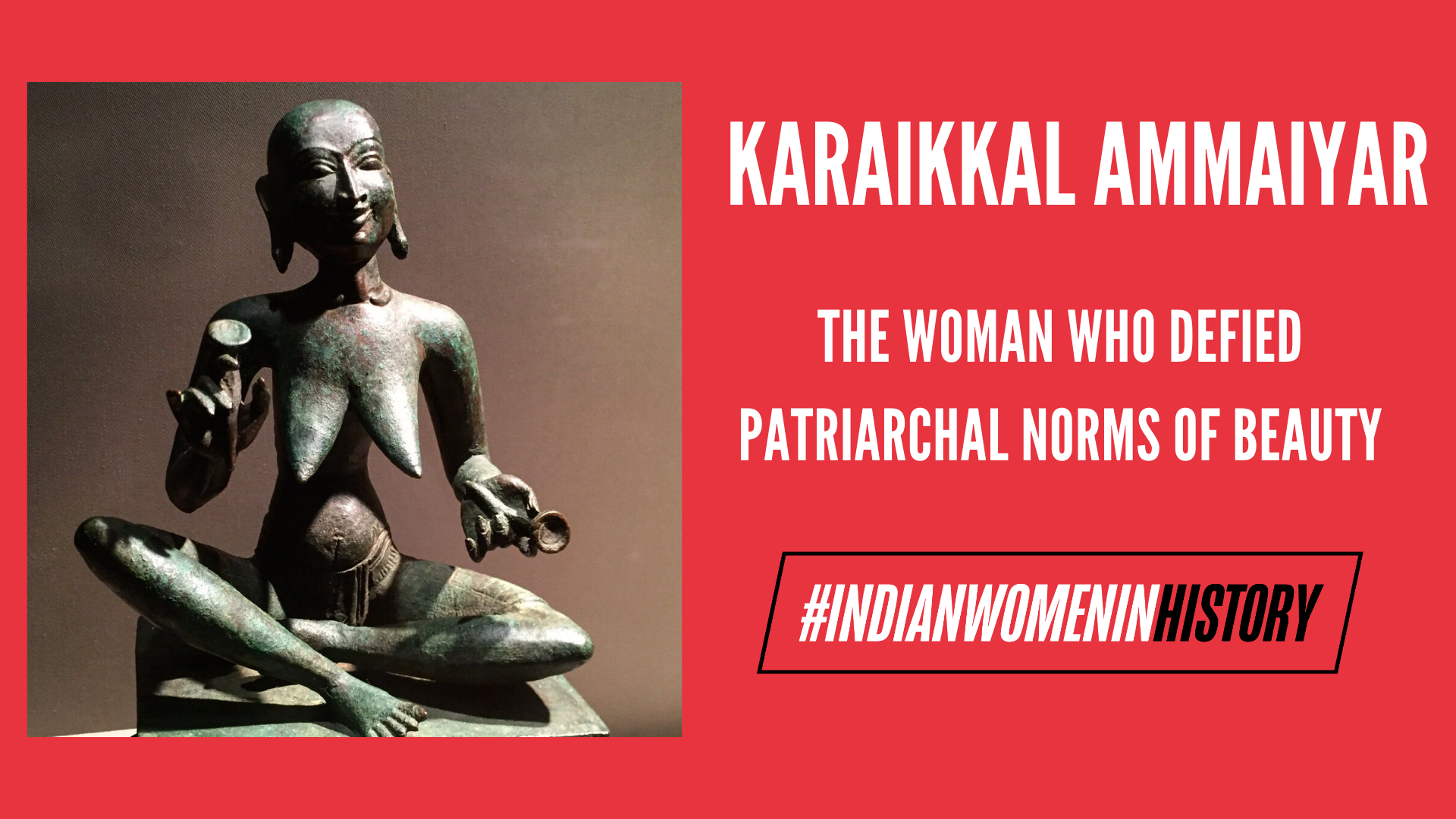Karaikkal Ammaiyar is one of the greatest figures of early Tamil literature, a Bhakti poet and saint who probably lived during the 6th century AD. She was one of the three women amongst the 63 Nayanmars, a group of saints devoted to the Hindu god Shiva. “Ammaiyae” literally means mother. Today, somewhat unfortunately, it is not her poetry that is popular, but the story of her life as told in her hagiography by Cekkilar, a male court minister of the twelfth century. Two Tamil feature films have been made about Karaikkal Ammaiyar’s life in 1943 and 1973, an evidence of her continued popularity in the region.
According to Cekkilar’s story Karaikkal Ammaiyar was born at Karaikal, South India. She was the beautiful daughter of a wealthy merchant, named Punitavati, a devotee of Lord Shiva since childhood. She continued to remain devoted to Shiva after marriage. One morning, her husband sent two mangoes to the house. She gave one of the mangoes away to a hungry Shaiva mendicant because she had not prepared any food yet. She served the remaining mango to her husband as a dessert who asked for the second one.

She was worried and prayed to Lord Shiva. By miracle, another mango appeared in her hands which she served to her husband. The sweetness of the mango was incomparable, prompting him to ask where did she get it from. She reluctantly told him the truth but he did not believe her. He challenged her to get another mango in the same manner. Even though another mango appeared, it disappeared as soon as he touched it. He decided that she was a local goddess, left her and married another women and began worshipping her.
She was one of the three women amongst the 63 Nayanmars, a group of saints devoted to the Hindu god Shiva. “Ammaiyae” literally means mother.
This story was written more than 500 years after the saint’s lifetime. Karaikkal Ammaiyar’s poetry simply does not provide details of the personal history of the saint found in the narrative. But it is quite clear that the role of a saint-goddess and a wife were considered incompatible, even though it is not explicitly stated why. The reason can however be inferred, a wife’s unmediated access to God disturbs the hierarchical nature of the husband-wife relationship. The fulfillment of the domestic duties of a wife was certainly considered very important, a slight breach is enough for her to call upon a miracle. It is the husband’s mango she gives away. She has no right over household goods and so she has to come up with another mango secretly.

According to the story Karaikkal Ammaiyar utters her first poem after her husband accepts her as a Goddess. She then wishes to shed her beauty to attain the form of the ghouls who venerate Shiva’s sacred feet. She begins a pilgrimage to Mount Kailasha where Lord Shiva lives. As she passes, people remark on her strange form with both admiration and fear, to which she responded, “If God recognizes me, why would I need a form recognizable to men in all directions who remain mired in ignorance?” Here is how she describes herself in one of her compositions:
One female ghoul
has shriveled breasts
bulging veins
hollowed eyes
bared teeth
a bloated belly
copper-colored hair
fangs
knobby ankles and elongated shanks;
Karaikkal Ammaiyar’s poetry simply does not provide details of the personal history of the saint found in the narrative. But it is quite clear that the role of a saint-goddess and a wife were considered incompatible, even though it is not explicitly stated why.
Even though Kariakal Ammaiyar’s story is deeply rooted in patriarchal norms, she does not take the form of a benevolent, beautiful, domesticated Goddess (like that of Lakshmi). What is fascinating is that she absolutely defies all patriarchal norms of beauty, taking a fearful and reverential image. Even though the rejection of beauty is done in favour of religion, it is radical amid a tradition that often associates beauty with virtue. She rejects a body that is socially validated, ‘a form recognizable to men’, a form that is associated with mediation and commodification. She places no value in beauty or appearance as long as God can recognize her. The story offers an implied critique of a social world that has no space for a religiously devoted women who has to live as an antisocial being.
This incompatibility between wifehood and religious virtuosity is not unique to Karaikkal Ammaiyar. For instance, Andal from Tamil Vaishnavism of the ninth century and Mirabai of northern Indian bhakti traditions of the sixteenth century both reject mortal marriage and instead wed themselves to God. The Bhakti tradition provided a mode of living other than traditional wifehood and motherhood to women. They did not join an alternative order or become nuns. Their mere existence and popularity becomes a threat to patriarchal authority.
References
Chosen Moments: Mediation and Direct Experience in the Life of the Classical Tamil Saint Kāraikkāl Ammaiyār by Karen Pechilis
About the author(s)
Khushi Agarwal is an English Literature student from Miranda House and an enthusiastic volunteer for women and child development. Writing is her chosen mode of expression and activism.




